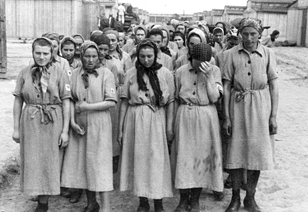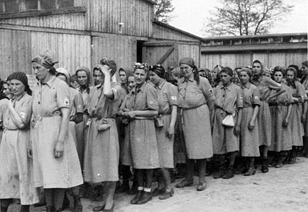Hungarian Jewish Women in the Kanadakommando
In 1944 430,000 Hungarian Jews were deported to Auschwitz by Hungarian authorities collaborating with the Nazis. The majority of the men performed labour service, therefore there were approximately a quarter of a million women or young girls among the deported. Most of them were gassed immediately upon arrival, but tens of thousands of Hungarian Jewish women were forced to perform slave labour in work units. The Kandakommando of Birkenau was considered to be one of the best workplaces.
The mass extermination of the Jews in Auschwitz commenced in 1942. Between March and December, 197,000
 |
Kanada workers arranging the luggage of the deportees at the Birkenau ramp |
In Sector BIIg of the Birkenau camp, an additional thirty huge barracks were built in December 1943. The group working there in the new warehouse camp (Kanada II or Effektenlager II) was officially called the "cleaning work unit" (Aufräumungskommando), but the unit was called "Kanada" by both the prisoners and the SS. Some of the members of Kanada were always working in the warehouse camp, while others performed service on the ramp when a new transport arrived. They opened up the doors of the cattle cars, helped the deportees get off, then under the strict supervision of the SS, they arranged the men and women into separate columns, consisting of rows of five. They gathered the luggage scattered on the ramp and left in the cattle cars, loaded everything onto a truck and transported the freight to the Kanada. The sorting began here: the suitcases were opened, and the objects were scanned through and sorted by type. All signs of the original owners' identities (name, yellow star) were demolished.
A majority of the owners were executed in the gas chambers by the SS; those capable of work were sent to the camp after having been completely looted. The plundered property filled thousands of freight cars. The transports were sent to the Reich and the objects were distributed among the German civilian population and the members of the armed forces.[2]
Arrival
The mass deportation of Hungarian Jews commenced on May 15, 1944. The first transports arrived the next
 |
Looted goods are transferred to the Kanada on trucks |
In Kanada II more than one work unit worked at the same time in alternating shifts. Each group had its own uniform. Helén Mauskopf and Helén Steinberg worked in the group with the white kerchiefs. This group of 700 was lead by a Slovakian capo named Manci and a Polish one named Erna: "They talked much about their lives in the camp: when they had arrived, there were fields in the place of the camp, which they constructed. They had slept on the floor and the camp was still full of dirt and lice..."[6] Sixteen young women from Munkács also worked for the white kerchief team: "All of us were put into the so-called white kerchief team. Our job was to sort out the clothes taken off by people of the transports and to pack them for transportation. We only had to pack the delicate and good clothes, and tore the rest into pieces to serve as rags."[7] Sarolta W. and her comrades had white and blue dotted dresses and white kerchiefs.[8] Mrs Dezső Katz neé Ilona Ungár from Budapest arrived to Auschwitz from the Kistarcsa internment camp on the 30th of April. After spending 3 weeks in quarantine she was assigned to the Kanada along with thirty companions. They wore striped prisoners' uniforms and red kerchiefs. "I spent around four months here. We worked with the clothes of dead people. We found documents and photos in their pockets."[9] Róza Moskovits and Aranka Stadler worked in the same work unit.[10]
Many Hungarian women working in the warehouse camp in Birkenau called it
 |
Hungarian Jewish women in the Kanadakommando |
Provisions and working conditions
In the summer of 1944, the number of prisoners in the Auschwitz complex amounted to 135,000. A great majority of them performed slave labour in scant attire, barefoot or in wooden clogs, suffering from constant hunger. Compared to these inmates, the women working in the Kanadakommando were definitely lucky. Their situation was assessed as follows by Rózsi and Lili Berkovits, sisters deported from Munkács: "This was an enviable place where one could have some extra bites of food and did not need to starve. We sorted out the luggage that the transports of people took here, and we always found food in them, which we could secretly seize and this saved us from starving to death."[12]
Sarolta W., a 16-year-old girl from Beregbród gave a descriptive account on the work performed in the Kanada: "One could find here everything starting from clothes, food, and bedclothes to the most expensive jewellery, precious letters and photos. We saw the most beautiful things here since everyone brought here the best belongings they had because no one thought that even that last rucksack would be seized.... Our job was relatively easy and good. For example, not even selections did pertain to us, so we did not have to be anxious about our lives all the time."[13]
Treatment
The unique behaviour standards of the Kanadakommando were developed in Auschwitz in the
Words of the survivors - link centerWe had to watch all the transports marching right into the gas chambers We worked with the clothes of dead people. We found documents and photos in their pockets. |
In Kanada II in Birkenau, the customs were the same in 1944: "We were not allowed to keep anything. They searched us every week and if they found something on someone they would cut her hair off, beat her up or send her to do another job," remembered the aforementioned 16-year-old girl from Beregbród.[15] Two teenagers from Munkács found their own things in the stack of cloths piling up in the Kanada. "We also found our own stuff, and we wanted to put on our sweaters because we were very cold. However, when they noticed it they gave us 25 blows and seized all that we had."[16]
Psychological burdens
Women assigned to the Kanadakommando were working under better circumstances than the
 |
Hungarian deportees sorting luggage in the Kanada |
Sixteen young women from Munkács who worked in the white kerchief unit reported on their memories in a collective protocol in 1945. Sári Moszkov was the oldest at 35 years old, while the youngest was Vera S., 14 years old. "This work was basically not difficult but the conditions under which we worked were awful. The crematorium was in front of us, and we could see how they selected each transport that arrived, we could see the elderly and children entering the gate of the crematorium, we could hear the horrible screams but we never saw anyone coming out. On the whole, it was easy for us because we had great quantities of stolen food but no one could eat it hearing all those screams, breathing an air that was stinking of burnt human flesh."[17]
Mrs Koltay from Budapest arrived with the first Kistarcsa transport to Birkenau.
Words of the survivors - link centerWe had to watch all the transports marching right into the gas chambers We worked with the clothes of dead people. We found documents and photos in their pockets. |
It occurred that they found the corpses of suffocated babies, who had been hidden by their mothers who had misgivings.[19] Other times, dead babies were found among the piles of clothes left in the dressing rooms of the gas chambers.[20]
The worst moments were when the women who were sorting luggage found belongings of their murdered family members. A girl from Alsóverecke found the clothes of her 7-year-old sister. Rella Katz and her sisters sorted the luggage of their mother and younger brother.[21] The Grünfeld sisters stole from their own suitcases the photograph of their father, who was murdered in the gas chamber. "We hid it in our shoes and that was how we kept it for a year, which was quite a thing because they searched us all the time ... We still have the photo even if it is torn and tattered. It is the only memory that remained of our parents."[22] Erzsébet S., a nurse from Beregszász, witnessed that naked women selected out during a camp selection were taken to the crematorium on trucks. In one of the groups she recognised her grandmother and several relatives.[23]
Beyond the borders of psychological endurance
Women working in Kanada generally performed easier work and lived under better sanitary
 |
Hungarian Kanada workers |
Twenty-one-year-old Aranka S. could not stand the work in the Kanadakommando for long. "I did this work only for three days because I could not stand the smell of the crematorium, and was not able to listen to the screams and cries of unfortunate children who were taken to be killed."[25] Instead of staying in the envied Kanada, Aranka managed to get assigned to work unit 110, where she carried stones, dug ditches and hauled sand in rain and mud. In Auschwitz-Birkenau, existence was a constant struggle to survive. It seems that with this decision Aranka consciously decreased her chances of survival. But actually her choice was rational: if she had stayed in the Kanada, her nerves would have been wrecked and she would have given up the struggle for life.
Footnotes
[1] Strzelecki 2000a, pp. II/149-151. On the origins of the name "Kanada" see Kraus-Kulka 1958, p. 57.
[2] According to a February 6, 1943 report from Auschwitz and Majdanek, 824 freight cars of clothing and footwear and a freight car of women's hair was shipped for certain offices. Published by Strzelecki 2000b, pp. 158-159. For the values looted in Auschwitz see Kádár-Vági 2005, pp. 208-214.
[3] See work unit 118-B (Entladekdo a.d. Rampe) on page 2 of the May 16, 1944 Auschwitz report of labour deployment (KL Auschwitz II. Arbeitseinsatz für den 16. Mai) Auschwitz-Birkenau State Museum D-AuII-3a.
[4] For the exact details, see Kádár-Vági 2005, pp. 152-156.
[5] Strzelecki 2000b, p. 28.
[6] Protocol 407.
[7] Protocol 254.
[8] Protocol 2969.
[9] Protocol 701.
[10] Stadler 1995, p. 142. Moskovits' testimony (Protocol 1931) is published by Kádár-Vági, 1999.
[11] Protocol 583.
[12] Protocol 169.
[13] Protocol 2969.
[14] The customs of the Kanada I are detailed by Vrba 2006, pp. 130-144.
[15] Protocol 2969.
[16] Protocol 2719.
[17] Protocol 254.
[18] Protocol 3523.
[19] Protocols 254, 970, 219 and 583.
[20] Protocol 443.
[21] Protocols 583 and 219.
[22] Protocol 2719.
[23] Protocol 180.
[24] Protocol 1513.
[25] Protocol 3206.
References
Kádár-Vági 1999
Kádár Gábor-Vági Zoltán: Magyarok Auschwitzban. (Hungarians in Auschwitz) In Holocaust Füzetek 12. Budapest, 1999, Magyar Auschwitz Alapítvány - Holocaust Dokumentációs Központ. pp. 92-123.
Kádár-Vági 2005
Kádár Gábor-Vági Zoltán: Hullarablás. A magyar zsidók gazdasági megsemmisítése. (Robbing the Dead. The Economic Annihilation of the Hungarian Jews.) Budapest, 2005, Jaffa-HAE.
Kraus-Kulka 1958
Ota Kraus-Erich Kulka: A halálgyár. (The Death Factory) Budapest, 1958, Kossuth.
Müller 1999
Filip Müller: Eyewitness Auschwitz. Three Years in the Gas Chambers. Chicago-Washington DC, 1999, Ivan R. Dee-United States Holocaust Memorial Museum.
Stadler 1995
Stadler Aranka: Egy rémálom emléktöredékei. (Memory Fragments of a Nightmare) In Bakó Ágnes-Szabó Éva-Verő Gábor (eds.): Emlékezések. (Recollections) Budapest, 1995, Magyar Auschwitz Alapítvány - Holocaust Dokumentációs Központ. pp.,122-166.
Strzelecki 2000a
Andrzej Strzelecki: Plundering the Victims' Property. In Waclaw Dlugoborski-Franciszek Piper (eds.): Auschwitz 1940-1945. Volume 1-5. Central Issues in the History of the Camp. Oswiecim, 2000, Auschwitz-Birkenau State Museum.
Strzelecki 2000b
Andrzej Strzelecki: Der Raub des Besitzes der Opfer des KL Auschwitz. In Hefte von Auschwitz 21, 2000, Verlag Staatliches Auschwitz-Museum. 7-99. o.
Vrba 2006
Rudolf Vrba: I Escaped from Auschwitz. London, 2006, Robson Books.

